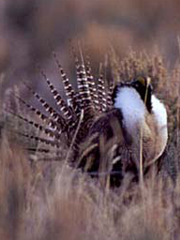|
Gunnison sage grouse } Centrocerus minimus

|
RANGE: Historically occurred in the southwestern portion of Colorado, southeastern Utah, northeastern Arizona, and northwestern New Mexico
STATUS: NatureServe considers the bird Critically Imperiled, but the U.S. Fish and Wildlife Service has decided the sage grouse is not in need of protection despite its low numbers.
THREATS: Loss and fragmentation of sagebrush habitat, mostly for agriculture
Extraordinary-looking birds — both splendid and comical with their ornamental fan of tail feathers and pouches under their chins that look like dangling pairs of eggs — male Gunnison sage grouse conduct an elaborate mating display to attract females. They strut, flap their wings against their white pouches, and emit a distinct series of sounds by vocalizing and popping the air sacs within those bizarre-looking pouches. They eat sagebrush in winter and forbs and insects the rest of the year, and therefore need sagebrush to survive. About 5,000 breeding Gunnison sage grouse remain in existence in seven separate populations in southwest Colorado and southeast Utah. By far the majority — about 4,000 birds — live in the Gunnison Basin.
|